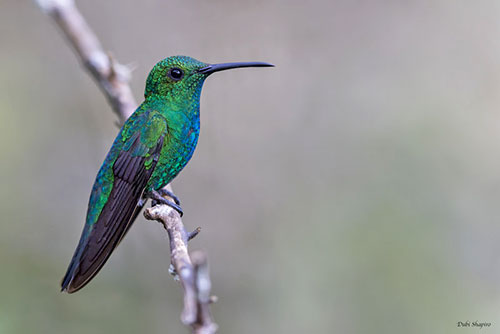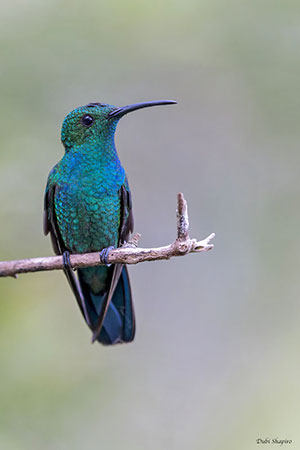
The Green Mango does not migrate but it may perform altitudinal movements according to the flowering season.
Like all the Trochilidae species, it is able to hover in all directions with 8-shaped rapid wingbeats.
REPRODUCTION OF THIS SPECIES:
The breeding season occurs between October and May.
The female builds a cup-shaped nest with woven plant fibres. This is a compact cup with the outer part decorated with lichen for better camouflage. The nest is attached to a vertical branch in tall tree, usually about 8 metres above the ground.
The female lays 2 white eggs and incubates alone. At hatching, the chicks are black and show two rows of down on the back. The male remains in nearby tree while the female incubates.
PROTECTION / THREATS / STATUS:
The Green Mango has restricted range. It is common resident in the C and W mountains of Puerto Rico.
This species is not currently threatened.
Fr: Mango vert
All: Smaragdmangokolibri
Esp: Mango Portorriqueño
Puerto Rico: Zumbador Verde
Ita: Mango verde
Nd: Groene Mango
Sd: Grön mango
Photographer:
Dubi Shapiro
Dubi Shapiro Photo Galleries
Text by Nicole Bouglouan
Sources:
HANDBOOK OF THE BIRDS OF THE WORLD Vol 5 by Josep del Hoyo-Andrew Elliott-Jordi Sargatal - Lynx Edicions - ISBN: 8487334253
BirdLife International (BirdLife International)
Aves de Porto Rico – Sociedad Ornitológica Puertorriqueña
Green Mango
Anthracothorax viridis
Apodiformes Order – Trochilidae Family
INTRODUCTION:
The Green Mango is a large hummingbird endemic to the archipelago of Puerto Rico, and mainly found in the mountainous areas of the main island. This species strongly defends its feeding trees against other hummingbirds.
DESCRIPTION OF THE BIRD:
Biometrics:
Length: 11-14 cm
Weight: 7 g
The adult has emerald green head and upperparts. The rounded tail is metallic blue-black.
The underparts are metallic blue-green.
The bill is black, fairly long and slightly down-curved. The eyes are dark brown. Legs and feet are blackish.
Both sexes are similar, but the female shows a tiny postocular white spot, absent in male.
The immature has head and back tinged brownish.

RANGE:
The Green Mango occurs in Puerto Rico.
HABITAT:
The Green Mango frequents forests and edges, and coffee plantations in C and W mountains. It can be seen in foothills too, but it is rare in coastal areas. This species is most common between 800 and 1200 metres of elevation.
CALLS AND SONGS: SOUNDS BY XENO-CANTO
The Green Mango gives an infrequent trill-like twitter.
BEHAVIOUR IN THE WILD:
The Green Mango feeds on nectar from several plant species such as flowering trees, shrubs and vines. It also catches insects, flies and beetles, and spiders. Insects are caught on the wing above the tree tops. Spiders are taken from leaves. It regurgitates the indigestible parts of its preys as pellets.
The nectar is taken by probing into the corollas with the curved bill, but it may sometimes pierce the flower at the base of the corolla to suck the nectar.
The Green Mango forages at all levels from the understorey to the tree tops. The male is known for defending its feeding area at flowering trees, and often defends only one tree against other hummingbirds.
During the breeding season, the male performs aerial displays, a U-shaped flight, in front of females. It may mate with several females, and the female probably has the same behaviour. After the copulation, male and female separate immediately. The male does not take part in nesting duties. However, it may stand guard close to the nest.
